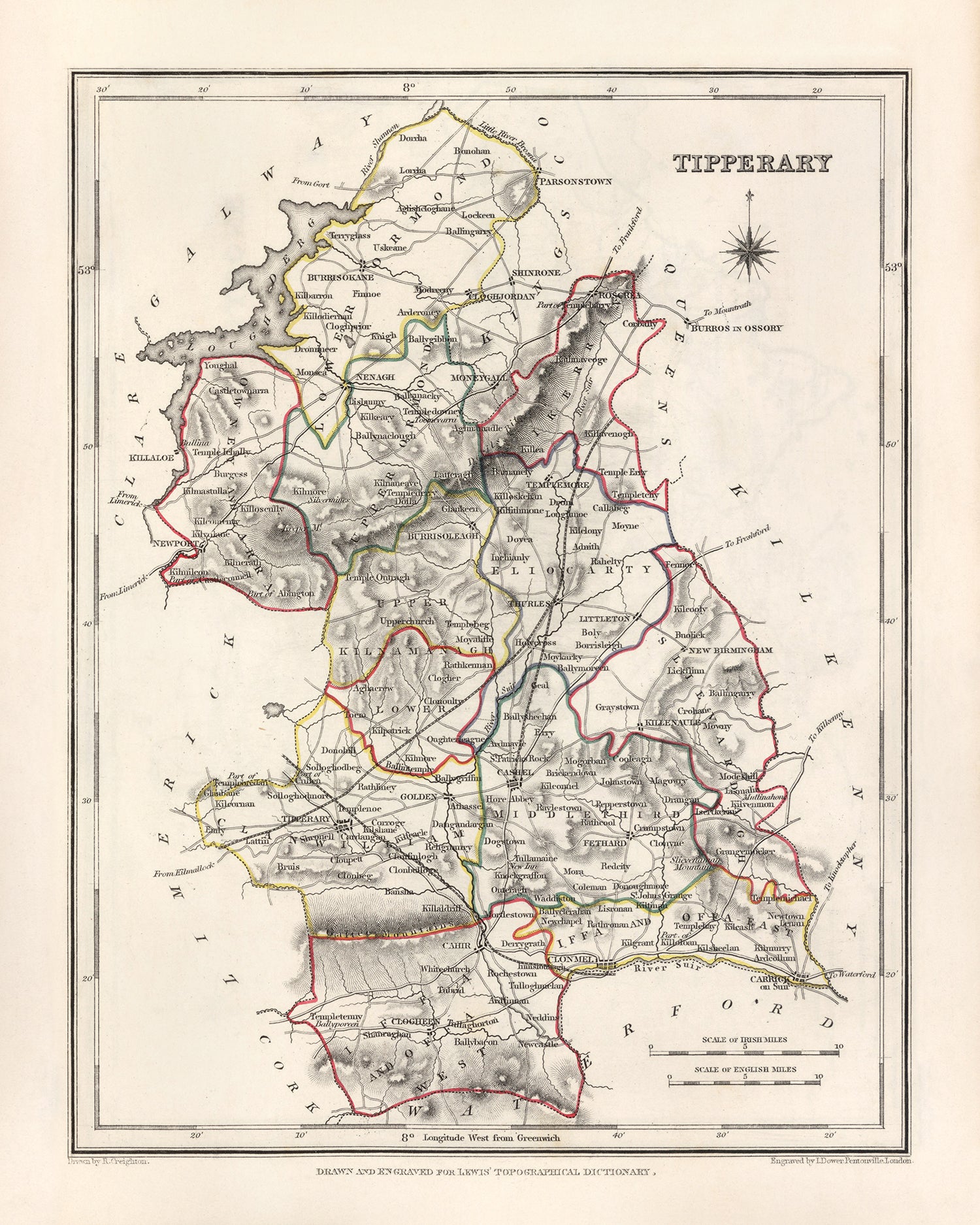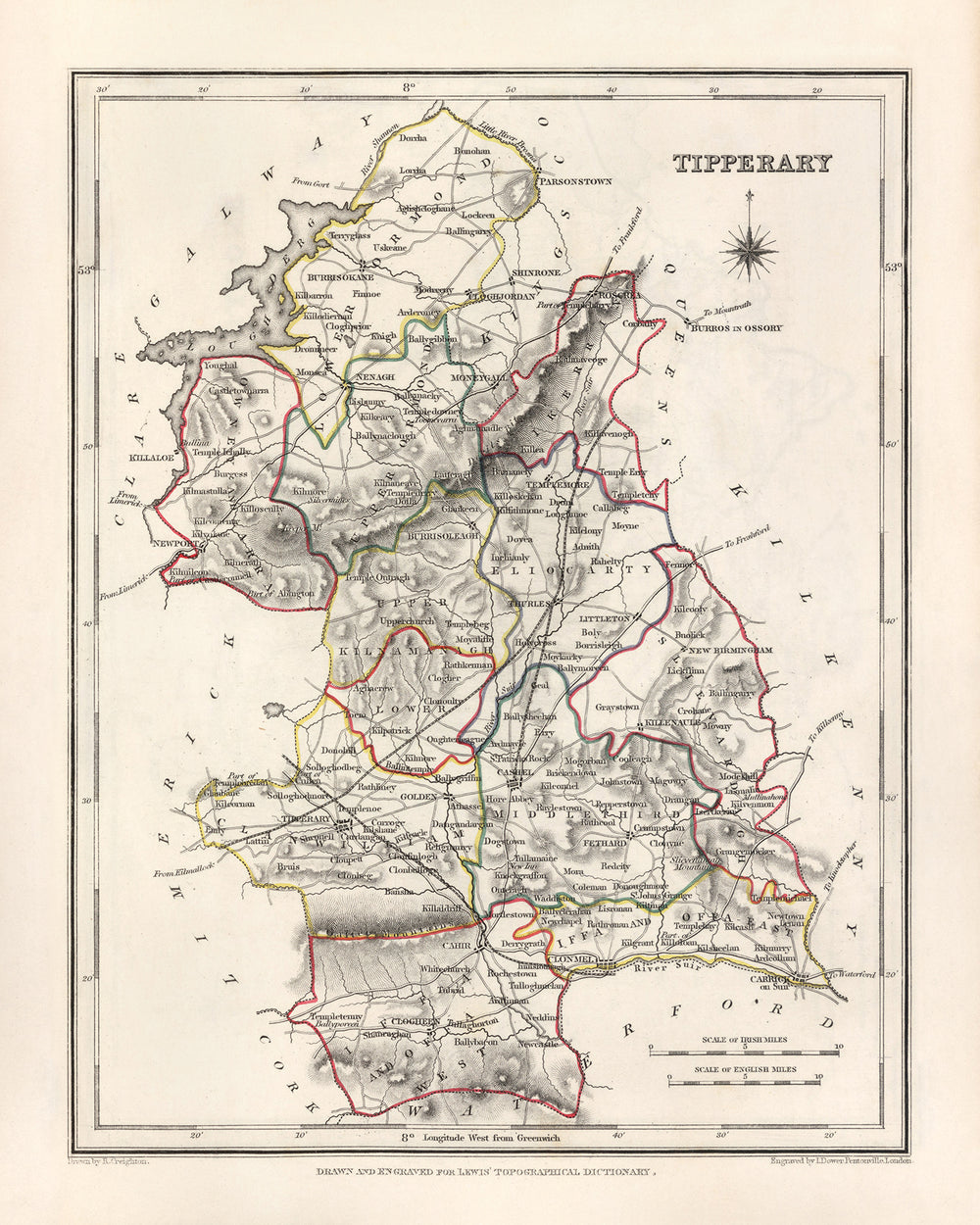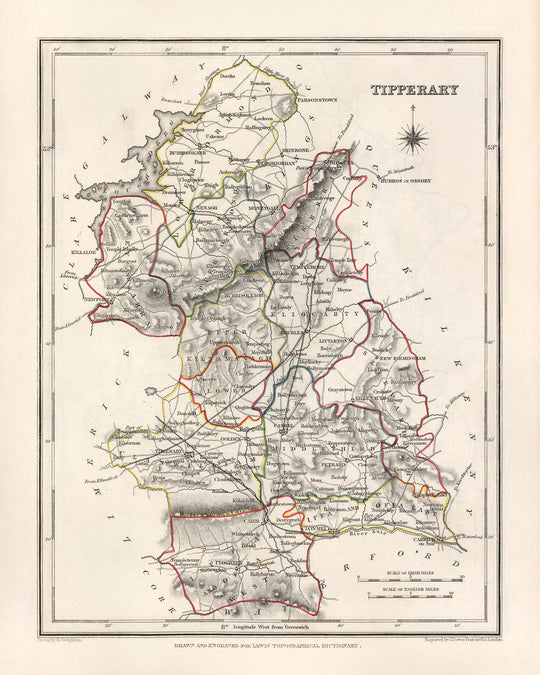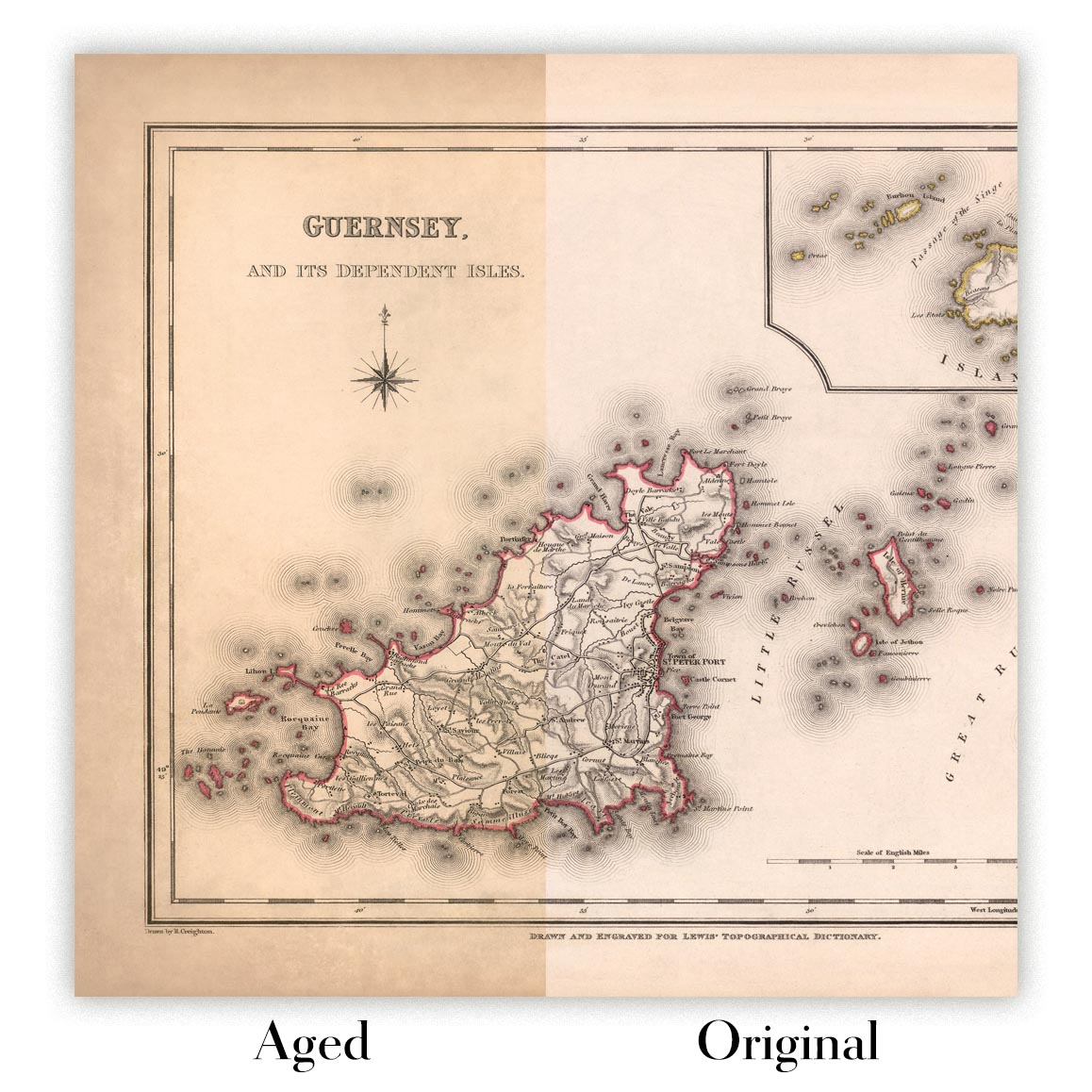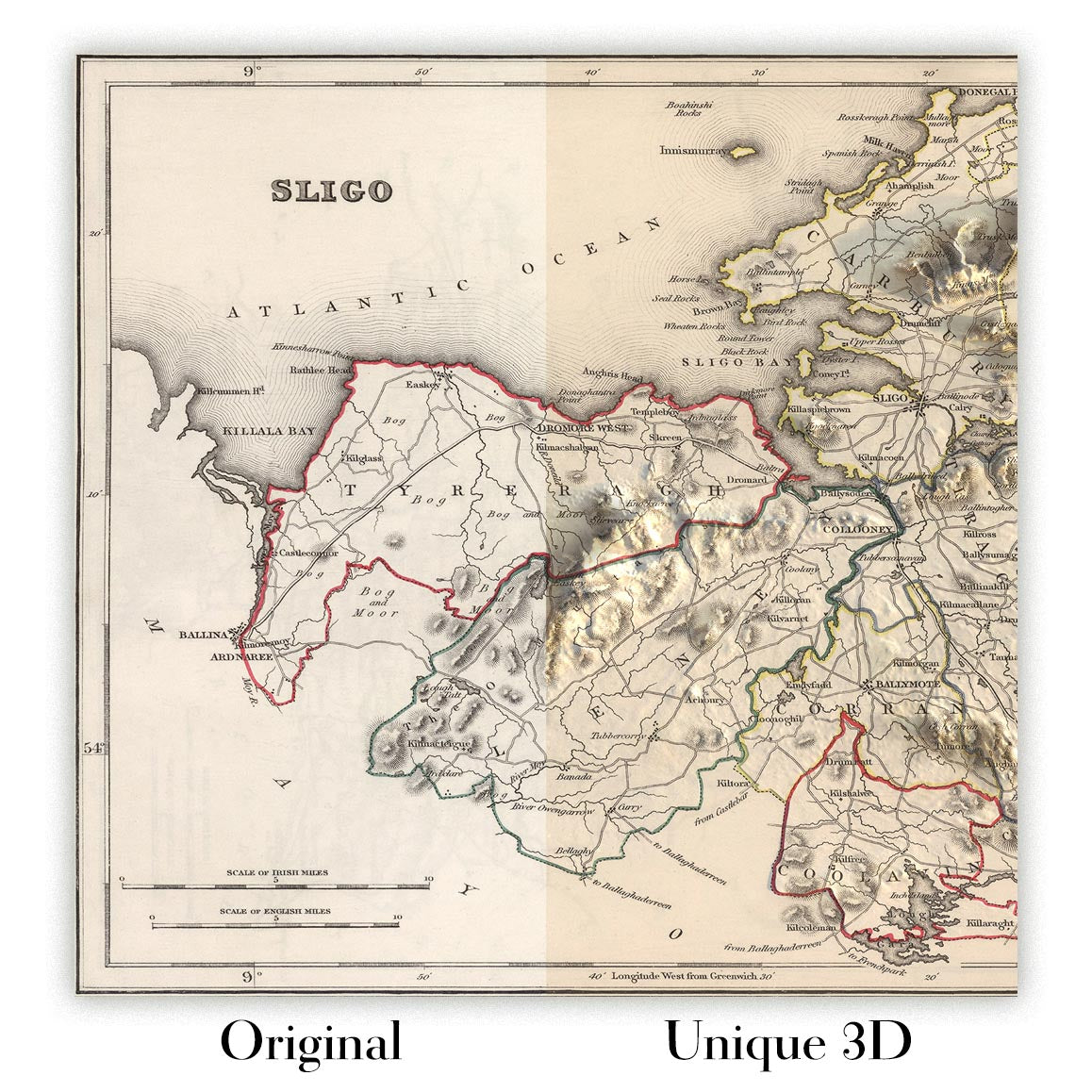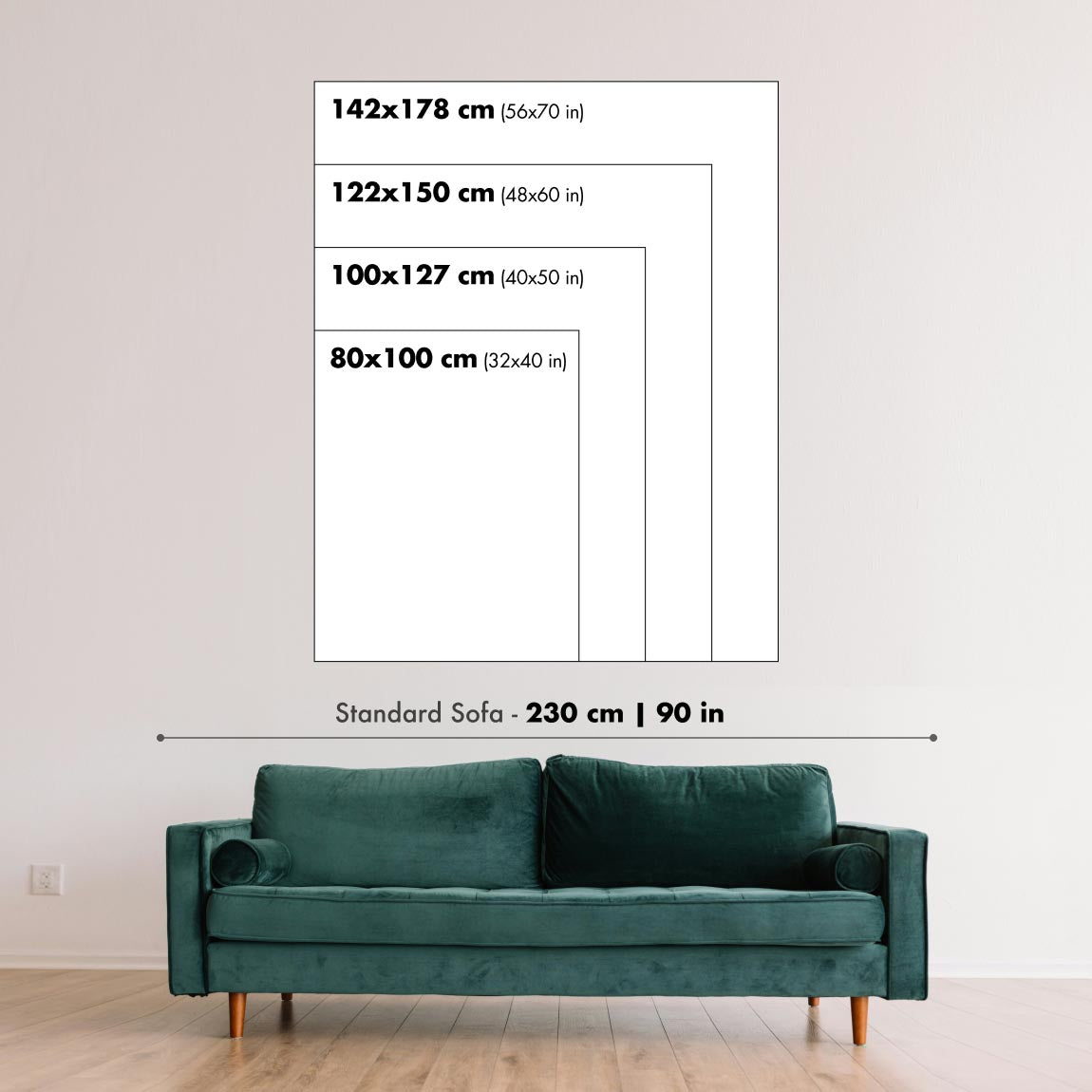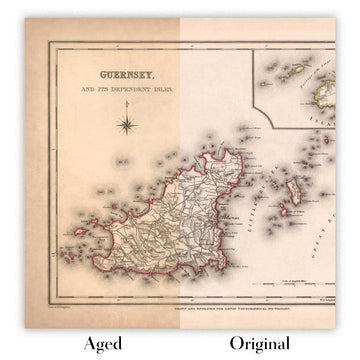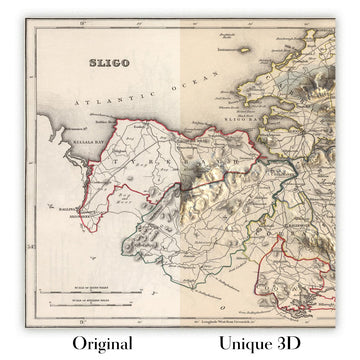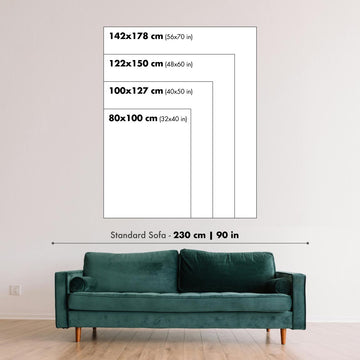- Handmade locally. No import duty or tax
- FREE Delivery by Christmas
- Love it or your money back (90 days)
- Questions? WhatsApp me any time
Own a piece of history
5,000+ 5 star reviews


Discover the rich history of County Tipperary with this high-quality reproduction of the "Old Map of Tipperary" by Samuel Lewis, originally published in 1844. This detailed and historically accurate map showcases the county’s mid-19th century boundaries, settlements, and geography in exquisite detail.
Key Features
- Includes Five Major Towns & Cities: Clonmel, Nenagh, Thurles, Cashel, and Cahir.
- Mid-19th Century Accuracy: A fascinating window into the past, with some towns appearing under earlier names.
- Perfect for History Lovers: A unique opportunity to explore the settlements and colonies of County Tipperary before 1840.
30 Historic Settlements Featured on the Map
Below is a list of notable towns and villages included on the map (founded before 1840), ordered by modern-day population size, each with a brief historical description:
Major Towns:
- Clonmel (1204) – Known for medieval architecture and former defensive walls.
- Nenagh (1192) – Home to Nenagh Castle; a blend of medieval and Georgian charm.
- Thurles (1192) – Birthplace of the GAA, with a historic cathedral.
- Cashel (5th century) – Site of the famous Rock of Cashel, with panoramic views.
- Cahir (13th century) – Dominated by the impressive Cahir Castle.
Other Settlements:
- Roscrea (6th century)
- Carrick-on-Suir (13th century)
- Templemore (9th century)
- Tipperary Town (13th century)
- Fethard (13th century)
- Killenaule (13th century)
- Ballina (13th century)
- Clogheen (13th century)
- Borrisokane (13th century)
- Templederry (13th century)
- Golden (13th century)
- Terryglass (13th century)
- New Inn (13th century)
- Bansha (13th century)
- Emly (13th century)
- Dundrum (13th century)
- Mullinahone (13th century)
- Newport (13th century)
- Cloughjordan (13th century)
- Lorrha (6th century)
- Toomevara (13th century)
Natural Features & Historical Context
This map also highlights Tipperary’s natural landmarks:
- The River Suir
- The Glen of Aherlow
- The Knockmealdown Mountains
Between 1800 and 1850, County Tipperary was shaped by significant events:
- The 1803 Irish Rebellion led by Robert Emmet
- The Great Famine
- The Young Ireland Movement, advocating for peaceful Irish independence
Available Sizes
This map looks stunning at all sizes, but especially when printed large:
- 12x16in (30.5x41cm)
- 16x20in (40.5x51cm)
- 18x24in (45.5x61cm)
- 24x30in (61x76cm)
- 32x40in (81.5x102cm)
- 40x50in (102x127cm)
Larger sizes (up to 50in / 127cm) available on request. Please contact me for custom or oversized prints.
Framing & Finish Options
- Available unframed or framed in a classic black frame
- Giclée printed on acid-free, archival matte paper
- Framed prints use museum-grade acrylic glazing — lightweight, safe, and less reflective than glass
- Custom frames and alternative finishes available upon request
The model in the listing photos is holding the 16x20in (40.5x51cm) version.
Personalisation
Looking for something more unique?
The fifth listing image shows an example of my map personalisation service. I can:
- Highlight specific towns or landmarks
- Add custom text or dedications
- Adjust colours or sizes to suit your space
Important Notes
- Not all modern towns or cities may appear — some are shown under historic names.
Need help finding a specific place on the map? Feel free to get in touch and I’ll happily check for you.
A Thoughtful Gift
This map makes a perfect birthday, Father’s Day, Christmas, anniversary, housewarming, or farewell gift for anyone connected to County Tipperary or Irish heritage.
This map is also available as a float framed canvas, sometimes known as a shadow gap framed canvas or canvas floater. The map is printed on artist's cotton canvas and then stretched over a handmade box frame. We then "float" the canvas inside a wooden frame, which is available in a range of colours (black, dark brown, oak, antique gold and white). This is a wonderful way to present a map without glazing in front. See some examples of float framed canvas maps and explore the differences between my different finishes.
For something truly unique, this map is also available in "Unique 3D", our trademarked process that dramatically transforms the map so that it has a wonderful sense of depth. We combine the original map with detailed topography and elevation data, so that mountains and the terrain really "pop". For more info and examples of 3D maps, check my Unique 3D page.
For most orders, delivery time is about 3 working days. Personalised and customised products take longer, as I have to do the personalisation and send it to you for approval, which usually takes 1 or 2 days.
Please note that very large framed orders usually take longer to make and deliver.
If you need your order to arrive by a certain date, please contact me before you order so that we can find the best way of making sure you get your order in time.
I print and frame maps and artwork in 23 countries around the world. This means your order will be made locally, which cuts down on delivery time and ensures that it won't be damaged during delivery. You'll never pay customs or import duty, and we'll put less CO2 into the air.
All of my maps and art prints are well packaged and sent in a rugged tube if unframed, or surrounded by foam if framed.
I try to send out all orders within 1 or 2 days of receiving your order, though some products (like face masks, mugs and tote bags) can take longer to make.
If you select Express Delivery at checkout your order we will prioritise your order and send it out by 1-day courier (Fedex, DHL, UPS, Parcelforce).
Next Day delivery is also available in some countries (US, UK, Singapore, UAE) but please try to order early in the day so that we can get it sent out on time.
My standard frame is a gallery style black ash hardwood frame. It is simple and quite modern looking. My standard frame is around 20mm (0.8in) wide.
I use super-clear acrylic (perspex/acrylite) for the frame glass. It's lighter and safer than glass - and it looks better, as the reflectivity is lower.
Six standard frame colours are available for free (black, dark brown, dark grey, oak, white and antique gold). Custom framing and mounting/matting is available if you're looking for something else.
Most maps, art and illustrations are also available as a framed canvas. We use matte (not shiny) cotton canvas, stretch it over a sustainably sourced box wood frame, and then 'float' the piece within a wood frame. The end result is quite beautiful, and there's no glazing to get in the way.
All frames are provided "ready to hang", with either a string or brackets on the back. Very large frames will have heavy duty hanging plates and/or a mounting baton. If you have any questions, please get in touch.
See some examples of my framed maps and framed canvas maps.
Alternatively, I can also supply old maps and artwork on canvas, foam board, cotton rag and other materials.
If you want to frame your map or artwork yourself, please read my size guide first.
My maps are extremely high quality reproductions of original maps.
I source original, rare maps from libraries, auction houses and private collections around the world, restore them at my London workshop, and then use specialist giclée inks and printers to create beautiful maps that look even better than the original.
My maps are printed on acid-free archival matte (not glossy) paper that feels very high quality and almost like card. In technical terms the paper weight/thickness is 10mil/200gsm. It's perfect for framing.
I print with Epson ultrachrome giclée UV fade resistant pigment inks - some of the best inks you can find.
I can also make maps on canvas, cotton rag and other exotic materials.
Learn more about The Unique Maps Co.
Map personalisation
If you're looking for the perfect anniversary or housewarming gift, I can personalise your map to make it truly unique. For example, I can add a short message, or highlight an important location, or add your family's coat of arms.
The options are almost infinite. Please see my map personalisation page for some wonderful examples of what's possible.
To order a personalised map, select "personalise your map" before adding it to your basket.
Get in touch if you're looking for more complex customisations and personalisations.
Map ageing
I have been asked hundreds of times over the years by customers if they could buy a map that looks even older.
Well, now you can, by selecting Aged before you add a map to your basket.
All the product photos you see on this page show the map in its Original form. This is what the map looks like today.
If you select Aged, I will age your map by hand, using a special and unique process developed through years of studying old maps, talking to researchers to understand the chemistry of aging paper, and of course... lots of practice!
If you're unsure, stick to the Original colour of the map. If you want something a bit darker and older looking, go for Aged.
If you are not happy with your order for any reason, contact me and I'll get it fixed ASAP, free of charge. Please see my returns and refund policy for more information.
I am very confident you will like your restored map or art print. I have been doing this since 1984. I'm a 5-star Etsy seller. I have sold tens of thousands of maps and art prints and have over 5,000 real 5-star reviews. My work has been featured in interior design magazines, on the BBC, and on the walls of dozens of 5-star hotels.
I use a unique process to restore maps and artwork that is massively time consuming and labour intensive. Hunting down the original maps and illustrations can take months. I use state of the art and eye-wateringly expensive technology to scan and restore them. As a result, I guarantee my maps and art prints are a cut above the rest. I stand by my products and will always make sure you're 100% happy with what you receive.
Almost all of my maps and art prints look amazing at large sizes (200cm, 6.5ft+) and I can frame and deliver them to you as well, via special oversized courier. Contact me to discuss your specific needs.
Or try searching for something!







